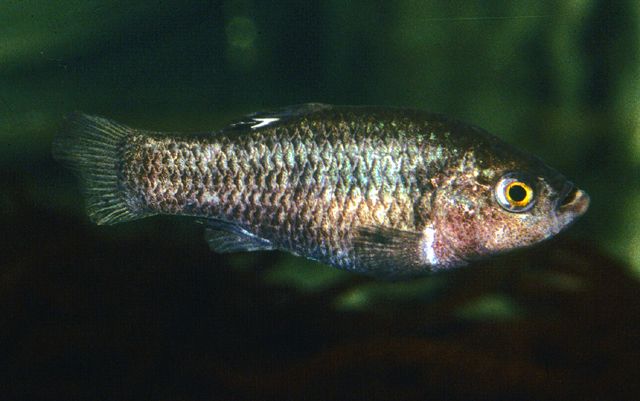| Cyprinodontidae (Pupfishes), subfamily: Cyprinodontinae |
| 5.5 cm TL (male/unsexed) |
|
benthopelagic; freshwater, non-migratory |
| Central America: Río San Juan system, Mexico. |
|
This species is distinguished from its congeners in having the following characters: maxilla short 0.70-0.77 times in anal fin base; head large 2.7-2.9 times in SL; male with 6-7 diffused dark bars along sides, covering only upper half of body; female with an irregular ocellus on dorsal fin, its black spot half-moon shaped, smaller than a pupil; eye 1-1.2 times in anal fin base; postdorsal-postanal 0.9-1.1 times in caudal peduncle length; anal fin usually smaller than its congeners, 3-3.9 times in head length; teeth absent on 4th ceratobranchial; dorsal fin inserted behind pelvic origin; nuptial males violaceous blue (Ref. 26729). |
| The springs at Ojo Charco Azul (= Barreno) are part of the Bolsón de Sandia complex, at 1600 m above sea level, and at the foot of Sierra Montelongo Pedregoso. The area is semiarid, with cacti other succulents; a densely woody area of cedar around the springs, except on the eastern side. Formerly the water was crystal clear at 19-20°C, but recently after depletion, the water is brown. Aquatic vegetation includes Ceratophyllum, Potamogeton, Typha, Eleocharis, Lemna, Utricularia, Scirpus, and Chara; crayfish Cambarellus sp. was observed. The bottom is loamy or muddy (Ref. 26729). Not a seasonal killifish. Is very difficult to maintain in aquarium (Ref. 27139). |
|
Extinct in the Wild (EW); Date assessed: 27 September 2018 Ref. (130435)
|
| harmless |
Source and more info: www.fishbase.org. For personal, classroom, and other internal use only. Not for publication.

